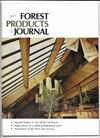杨家大院古建筑树种鉴定及木材构件材料劣化程度
IF 1.2
4区 农林科学
Q3 FORESTRY
引用次数: 1
摘要
本研究采用明场显微镜、偏振光、荧光、傅里叶变换红外(FTIR)光谱等方法,对杨家古院一院走道木质构件的树种鉴定及材料劣化程度进行了分析。结果表明:(1)根据古建筑中“局部选择”的选择原则和解剖结构特征的观察,从木柱根部采集的1号、2号、4号、3号、5号样品分别鉴定为白松木(Pinus bungeana)、杨木(Populus spp.)、大榆木(Ulmus macrocarpa)和云杉(Picea sp.)。(2)极化、荧光观察和FTIR光谱分析表明,结晶纤维素的双折射亮度严重降低,FTIR光谱分析表明,杉木和云杉木质组分中代表纤维素和半纤维素的吸收峰消失或减少。然而,杨树和榆树木质组分的偏振光谱、荧光光谱和FTIR光谱显示,晶体纤维素的双折射和吸收峰的亮度保持不变,与对照相同。(3)根据极化效应、荧光效应和FTIR光谱分析结果,得出黄松和云杉木质构件受褐腐真菌侵害较为严重的结论;相比之下,杨树和榆树的木质部分不受木材腐烂真菌的侵害,但受到昆虫的侵害。这些结果为后续的防腐处理和防虫等预防性保护提供了科学指导。本文章由计算机程序翻译,如有差异,请以英文原文为准。
Identification of Tree Species and Extent of Material Deterioration of Wood Components in the Yangjia Courtyard Ancient Building
The identification of the tree species and the extent of material deterioration in the wooden components of the walkway of the first courtyard of the ancient Yangjia Courtyard were analyzed in this study using bright-field microscopy, polarized light, fluorescence, and Fourier-transform infrared (FTIR) spectroscopy methods. The results are as follows: (1) samples No. 1 and No. 2, and No. 4, No. 3, and No. 5 taken from the roots of the wooden pillars were identified as lace-bark pine wood (Pinus bungeana), poplar woods (Populus spp.), large-fruited elm wood (Ulmus macrocarpa), and spruce wood (Picea sp.), respectively on the basis of observation of anatomical structural characteristics and analysis of selection principle of “local selection” in ancient buildings. (2) The observation of polarization and fluorescence and the analysis of FTIR spectra showed that the brightness of crystalline cellulose birefringence reduced severely, and analysis of FTIR spectra showed that the absorption peaks representing cellulose and hemicellulose in the lace-bark pine and spruce wooden components disappeared or decreased. However, the polarization and fluorescence and the FTIR spectra of the poplar and elm wooden components showed that the brightness of the crystalline cellulose birefringence and the absorption peaks remained constant, as the controls did. (3) According to the results of the effects of the polarization and fluorescence effects and the FTIR spectra, we concluded that the lace-bark pine and spruce wooden components were severely attacked by brown rot fungi; in contrast, the wooden components of poplar and elm were not attacked by wood decay fungus, but were attacked by insects. These results provide scientific guidance for subsequent preventive conservation such as preservative treatment and insect prevention.
求助全文
通过发布文献求助,成功后即可免费获取论文全文。
去求助
来源期刊

Forest Products Journal
工程技术-材料科学:纸与木材
CiteScore
2.10
自引率
11.10%
发文量
30
审稿时长
6-12 weeks
期刊介绍:
Forest Products Journal (FPJ) is the source of information for industry leaders, researchers, teachers, students, and everyone interested in today''s forest products industry.
The Forest Products Journal is well respected for publishing high-quality peer-reviewed technical research findings at the applied or practical level that reflect the current state of wood science and technology. Articles suitable as Technical Notes are brief notes (generally 1,200 words or less) that describe new or improved equipment or techniques; report on findings produced as by-products of major studies; or outline progress to date on long-term projects.
 求助内容:
求助内容: 应助结果提醒方式:
应助结果提醒方式:


